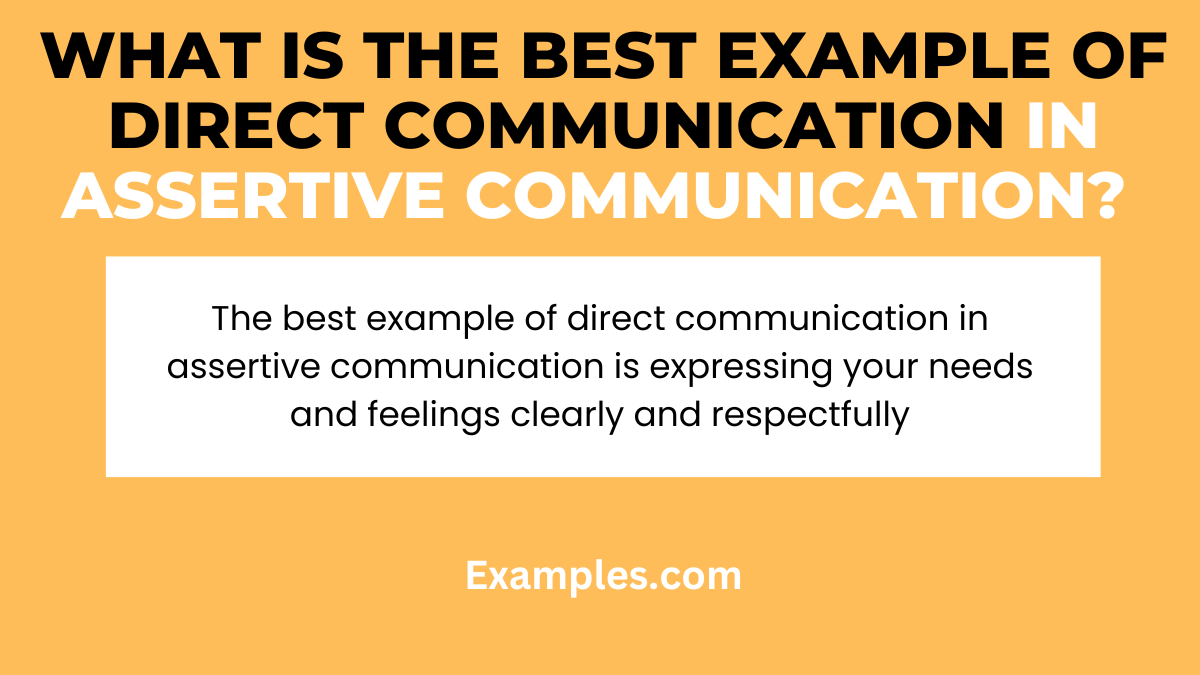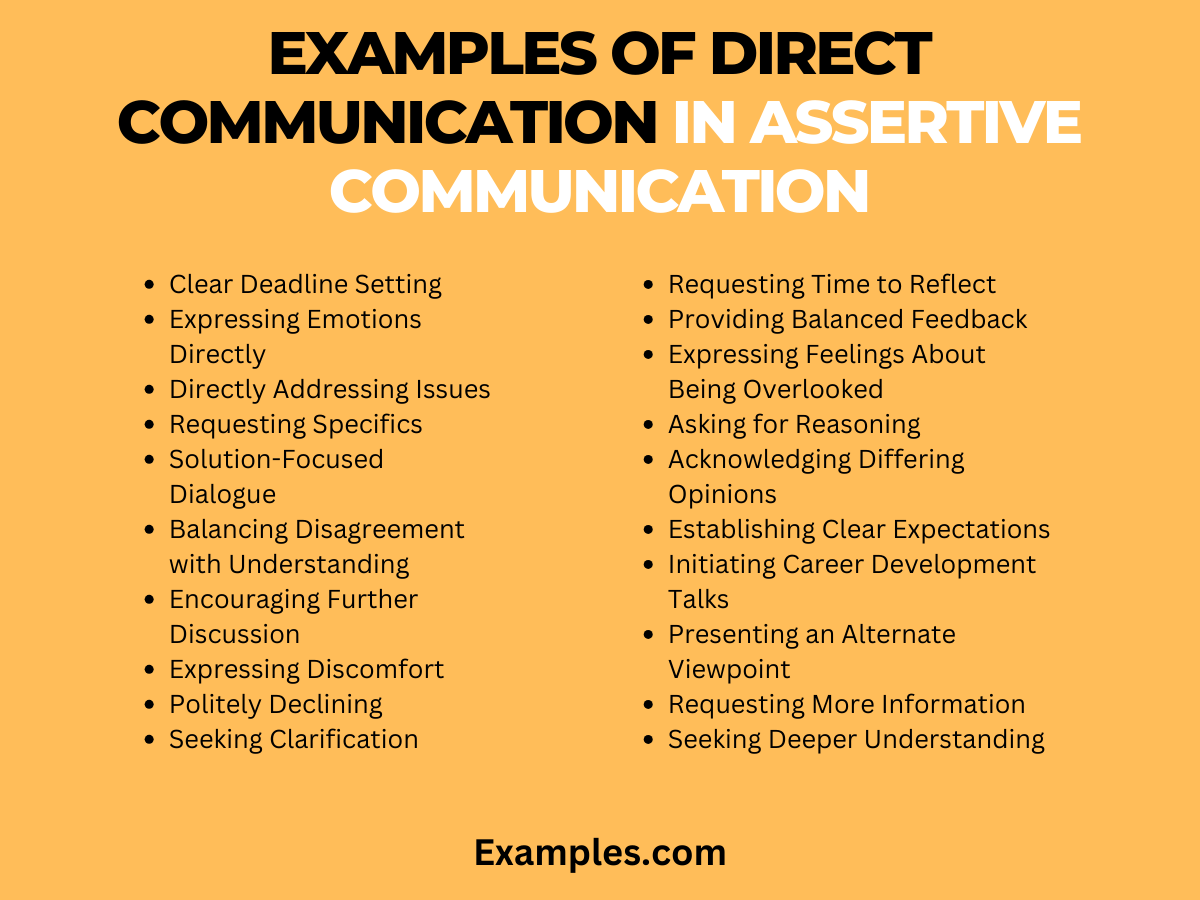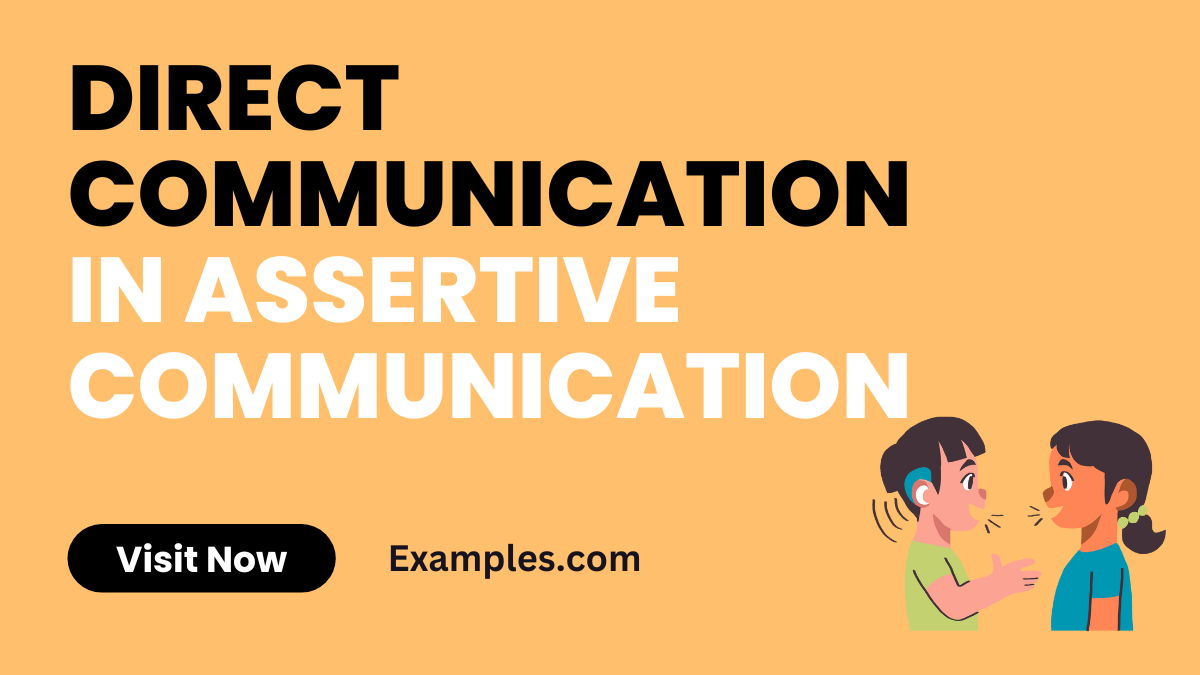19+ Direct Communication in Assertive Communication Examples
Embark on a journey to masterful communication with our comprehensive guide to Direct Communication in Assertive Communication. This guide unveils the nuances of conveying your thoughts and feelings directly, yet respectfully. Assertiveness is not about dominance but about clarity and confidence in communication. By understanding the principles of direct communication within the assertive style, you can express yourself clearly, listen actively, and respond empathetically. Dive into our guide to refine your communication skills, fostering both personal and professional growth.
What is Direct Communication in Assertive Communication?

Direct Communication in Assertive Communication is a method where individuals clearly express their thoughts, feelings, and needs without encroaching on others’ rights. It’s a balanced approach that combines confidence and respect, ensuring that messages are conveyed effectively while maintaining positive relationships. This style is characterized by open, honest expression and a solution-oriented approach, emphasizing clarity and empathy.
What is the Best Example of Direct Communication in Assertive Communication?

A prime example of Direct Communication in Assertive Communication is when a person addresses a concern directly to a colleague in a work setting. Instead of using indirect or passive-aggressive means, they approach the colleague and clearly express their concerns using “I Statements in Assertive Communication” and maintaining a “Respectful Tone in Assertive Communication”. This approach not only addresses the issue at hand but does so in a manner that respects both parties and encourages constructive dialogue.
20 Examples of Direct Communication in Assertive Communication

Direct Communication in Assertive Communication is essential in establishing clear, respectful, and effective interactions. It involves expressing one’s thoughts, feelings, and needs honestly and straightforwardly while respecting others. This method enhances clarity and prevents misunderstandings, making it a crucial skill in personal and professional settings.
- “I need this report by tomorrow afternoon, please.” (Clear deadline setting)
- “I feel upset when meetings start late.” (Expressing emotions directly)
- “Can we discuss your decision? I have some concerns.” (Directly addressing issues)
- “I appreciate your help, but I need more information.” (Requesting specifics)
- “Let’s find a solution that works for both of us.” (Solution-focused dialogue)
- “I disagree with your point, but I understand your perspective.” (Balancing disagreement with understanding)
- “Your feedback is valuable; can you elaborate?” (Encouraging further discussion)
- “I’m not comfortable with this arrangement.” (Expressing discomfort)
- “Thank you, but I cannot commit to this task right now.” (Declining politely)
- “I believe there’s a misunderstanding; let’s clarify.” (Seeking clarification)
- “I need some time to think about your proposal.” (Requesting time to reflect)
- “Your work has improved, but let’s focus on these areas.” (Providing balanced feedback)
- “I feel unheard in meetings; let’s change that.” (Expressing feelings about being overlooked)
- “Can you explain why this decision was made?” (Asking for reasoning)
- “I value your input, but I have a different view.” (Acknowledging differing opinions)
- “Let’s set a deadline to ensure timely completion.” (Establishing clear expectations)
- “I’d like to discuss my performance and growth opportunities.” (Initiating career development talks)
- “I understand your point, but here’s my perspective.” (Presenting an alternate viewpoint)
- “Can we revisit this topic with more data?” (Requesting more information)
- “I’m not sure I agree; can you provide more context?” (Seeking deeper understanding)
What is the Format for Direct Communication in Assertive Communication?
Direct communication in assertive communication is characterized by clarity, honesty, and respect. This format involves expressing your thoughts, feelings, and needs openly and honestly, while also respecting the perspectives of others. It typically includes:
- Clarity of Message: Clearly stating your message without ambiguity.
- Use of ‘I’ Statements: Expressing your views and feelings by starting sentences with ‘I’ to own your message and reduce defensiveness in others.
- Respectful Tone: Maintaining a calm and respectful tone, even during disagreements.
- Active Listening: Listening to others actively to understand their perspective.
- Body Language: Using assertive body language, such as maintaining eye contact and an open posture.
- Empathy: Showing understanding and empathy towards others’ feelings.
- Non-Verbal Cues: Being aware of and using appropriate non-verbal communication.
- Feedback: Providing constructive feedback and being open to receiving it.
- Boundary Setting: Clearly stating your boundaries and respecting others’ boundaries.
- Conflict Resolution: Engaging in problem-solving and negotiation to resolve conflicts.
Importance of Direct Communication in Assertive Communication
- Enhances Clarity: Direct communication minimizes misunderstandings and ensures that your message is conveyed clearly.
- Builds Respect: By being direct and respectful, you earn respect from others.
- Improves Relationships: It fosters healthier and more honest relationships, both personally and professionally.
- Encourages Honesty: Direct communication creates an environment where honesty is valued.
- Boosts Confidence: Regularly practicing direct communication can increase your self-confidence.
- Facilitates Problem-Solving: It enables more effective problem-solving and decision-making.
- Reduces Stress: Clear communication can reduce stress and anxiety associated with misunderstandings or unexpressed feelings.
- Promotes Assertiveness: It is a key component in developing and maintaining an assertive communication style.
- Enhances Emotional Intelligence: Practicing empathy and understanding in communication improves emotional intelligence.
- Supports Personal Growth: Direct communication encourages personal growth by challenging you to express your true self.
Direct communication in assertive communication is crucial for effective interpersonal interactions. By adhering to the principles and tips outlined in this guide, individuals can enhance their ability to express themselves confidently and respectfully. This skill not only fosters clearer communication but also promotes understanding and cooperation in both personal and professional relationships.



